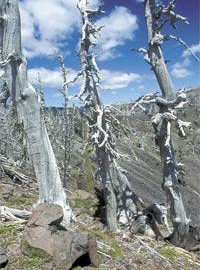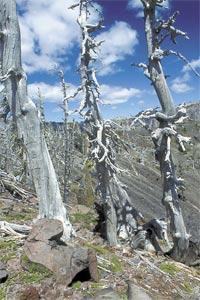CRATER LAKE PINES IN PERIL – OCTOBER 01, 2005
Herald and News
Klamath Falls, Oregon
October 01, 2005
By LEE JUILLERAT
Whitebark pine is possibly Crater Lake National Park’s signature tree species.
|
Many are seen by motorists who stop at overlooks and picnic areas along west Rim Drive, but they’re more appreciated by hikers who trek around Wizard Island’s summit crater.
Whitebarks are easily identified by their whitish-gray bark and, even more, by their wind-twisted and contorted limbs.
But whitebark pines at Crater Lake, and throughout high elevation, sub-alpine reaches of the American West, are dying at an alarming rate from blister rust, an exotic pine disease. Because blister rust is non-native, trees have very little resistance.
The disease has killed more than 90 percent of the whitebarks in the northern Rocky Mountains and is threatening similar devastation throughout stands along the Pacific Coast and inland Northwest.
Concerns about whitebark pines, especially along the western United States and Canada, will be the focus of a three-day Pacific Coast Whitebark Pine Workshop at Crater Lake Tuesday though Thursday.
About 20 biologists and scientists will gather at the park to share information on whitebark pine projects from California to British Columbia and plan for a Pacific Coast Whitebark Pine Symposium in 2006.
“This really is a serious issue,” said Ron Mastrogiuseppe of the Crater Lake Institute, which is sponsoring the workshop. “Crater Lake is significant because many people see whitebark pine at rim viewing points. Most people agree the whitebark enhances the beauty of the park’s landscape.”
Among those attending next week’s workshop will be Diana Tomback, a biology professor at the University of Colorado at Denver and head of the Whitebark Pine Ecosystem Foundation, a group working to find ways to ensure survival of the species.
“The infection rates are very, very high,” Tomback said. “There are restoration protocols people have been working out. It’s costly and labor intensive, and it’s going to take a lot of dedication on the part of resource agencies, including the National Park Service and Forest Service, to see this through.”
In areas where the blister rust has killed nearly 100 percent of the whitebarks, such as Glacier National Park, biologists have been collecting seeds from the few surviving trees for future replanting efforts. Because whitebarks are usually found at remote areas, Tomback said seed planting will be time consuming and costly.
“We have to all roll up our sleeves and forge ahead,” Tomback said.
Whitebarks are more than fascinating for their looks. Whitebark are regarded as a “keystone species” because many other life forms depend on the trees. Their nut-like seeds are an important food source for many birds and mammals, including Clark’s nutcrackers, squirrels and bears.
Unusually, the whitebark’s wingless seeds do not fall to the ground or float way. Instead, nutcrackers break open a cone, take a mouthful of seeds and fly away to bury them. It’s estimated an average nutcracker will harvest 110,000 seeds each summer and hide them in thousands of different locations. Most seeds, however, are never retrieved, which allows some to germinate.
“This is really a milestone,” Mastrogiuseppe said of the workshop, which he expects will lead to a larger, more comprehensive 2006 conference at Diamond Lake and Crater Lake.
Other pages in this section
*** previous title *** --- *** next title ***



